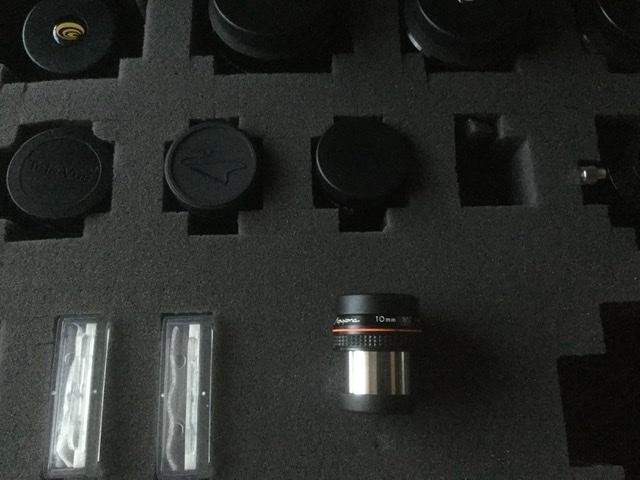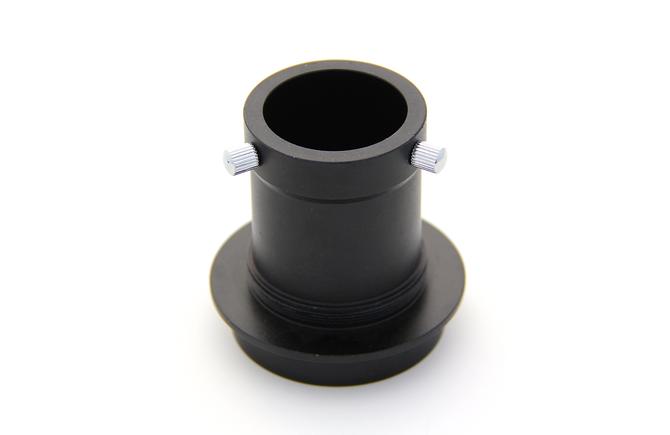-
Posts
53,760 -
Joined
-
Last visited
-
Days Won
455
Content Type
Profiles
Forums
Gallery
Events
Blogs
Posts posted by John
-
-
The tube length is critical as well as it's weight.
A light but long scope will overpower a mount even if it is well within the load limit.
For a while Celestron used to supply the C5 SCT on the EQ-2 mount as an option.
-
I've owned and used a couple of the Vixen NPL's and rather like them.
I read somewhere that the Vixen design uses a similar lens figure to the TV plossls (which is a slight variant on the standard plossl).
-
 1
1
-
-
To get a similar optical quality to the Starguiders I think you would need to consider the Baader 8-24mm zoom which cost about as much as 4 Starguider eyepieces. The less expensive zooms are OK but the Starguiders provide better overall performance in my experience.
At the 24mm end zooms have quite a narrow field of view so you would still ideally want a fixed focal length low power eyepiece as well as the zoom, say a 30mm or 32mm so the investment needed increases again.
-
 3
3
-
-
Thats not normal. Normally an eyepiece is fully inserted and the focuser would be somewhere in the middle of it;s range of travel when the scope is at sharp focus on an astro target.
Not all eyepieces reach focus at the same place so you need some movement available to be able to use them.
-
29 minutes ago, Sonmalul said:
Then why do they still produce scopes in the f10+ range alongside their identical aperture and mechanics, faster brothers?
what's the catch?
Seems to me that progress in the refractor world look like going from something lile this
to stuff like this
https://cdn2.skiesunlimited.com/images/D/09947_Orion_alt04.jpg
😜
A few years ago the long achromatic refractor was indeed dying out.
Over the past few years, influenced by a few articles and publications by authors such as Neil English, an interest in these traditional designs has reignited among some visual observers. So the vintage long refractors became sought after and some newly manufactured units have emerged, notably the 102mm F/11 achromat which Lyra Optics imported from the far east a few years back, Richard Day's composite creations (as showcased by @johninderby above, Moonraker Telescopes and there are a few more options now.
If these designs are appreciated, and enjoyed and people are prepared to spend their hard earned money on them, it's good that manufacturers have responded. Choice is a good thing I think

-
 1
1
-
-
16 minutes ago, Sweep said:
It is tiny, but perfectly formed.
I’m using in a 130mm Apo, and currently trying to decide whether to buy a 11” act or 10” classical cassegrain.
Edge of field not perfect on axis best of my collection, which include
Es 40mm 68
Es 30mm 82
Es 17mm 92
Es 12mm 92
Televue delete 7mm
Wo 4mm Uwan
Vixen 3.5mm ssw
Thanks. That's interesting to know

-
2 minutes ago, Sweep said:
What scope / scopes do you use it with and how is the edge sharpness ?
It is a heck of a lot smaller than the ES 92 / 17 that/s for sure !
-
26% illuminated this evening. Very beautiful.
Set my 100mm Tak up quickly to catch the very skinny Venus before it sank into the hedge.
On to the Moon hanging so temptingly in the sky.
Highlights include a trio of craggy craters on the terminator, Theophilus, Cyrillus and Catharina. The central peak in Theophilus looks really jagged and shattered in this light.
Posidonius further north with it's partial internal second rim which looks as if a major portion of the crater floor has been tilted somehow. 2 / 3 rilles cross the crater floor as well. Lots of geological action here over the aeons.
The long wrinkle system of the Dorsa Smirnov running for over 200km across the Mare Serenitatis.
Messier and Messier A plus rays nicely displayed again.
Certainly made up for the scrubbing of the Falcon launch. Maybe we will get back there one day

-
 4
4
-
-
I managed to get Venus myself at around 9:40pm. As soon as the Falcon launch was scrubbed I popped my Tak out and found Venus lurking between the soffit of my house and the hedge top !
Nice to observe it for a while - I think this is the slimmest that I've ever managed to see the phase

-
 2
2
-
-
Great catch Mike

According to the Virtual Planet Atlas software the phase is currently 1.8%.
With the phase so thin I think it is difficult to catch it accurately when imaged - my shots from last night (2.3% illuminated) were pretty much the same as it looked at 4% or even 6%. I guess there is only so much that mobile phone sensors and firmware can handle !
Your drawings are much more how it actually looks though the eyepiece - very delicate

-
 1
1
-
-
I have owned a Meade AR6 152mm F/8 refractor and the false colour is quite evident. It's OK for visual observing but I don't think an imager would find it acceptable. Also they are very large scopes to mount steadily.
Have you considered putting your 8SE tube onto a sturdy equatorial mount ?
-
-
I don't think those issues will affect performance of the scope at all.
Don't use the Baader fluid on the mirror - it is intended for lenses not aluminised surfaces.
I would just get on and use the scope. Look and the mirror clips and central obstruction - they cover far more area of the mirror than any of the marks or the tiny scratch and the scope still performs well.
-
 1
1
-
-
Sounds like the seeing was poor wookie.
Those globulars are usually rather nice even with 100mm of aperture.
Sounds like you did still get some nice stuff though

Sometimes it goes like that. I could not find Comet Panstarrs last night although it should have been visible with my scope. I gave up in the end and went onto the Cats Eye and Blinking planetary nebulae which were nice to observe and easily found.
-
What an interesting read Magnus. Thanks very much for showing us the workings of these scopes

Good to know for sure that these "Black Diamond" versions have the oversized primary mirror and therefore presumably operate at the full 180mm effective aperture.
-
 1
1
-
-
The above clothes peg trick does work.
There are other DIY was as well:
-
 1
1
-
-
2 hours ago, mikeDnight said:
Thanks Louis,
I've just ordered a 5mm Pseudo in the form of an Ultrascopic from ENS Optical, which should sooth the itch for a while. If only these 85° were 50° or even 40°, id have probably bitten long before now. Its interesting what you say about the purely positive design. Im going to have to read up in more depth about these and similar designs. ☺
I'll be interested to see what you think of that one Mike.
It was interesting that Orion commissioned the manufacturer to add a lower lens set with the 5mm and 3.8mm in their versions of this pseudo-Masuyama range. I presume this is to give better eye relief. I used to have the 5mm Celestron Ultima which did not use a lower lens set and the eye relief was pretty tight. Very nice optically though. There was never a Celestron Ultima 3.8mm - perhaps without a lower lens set the eye relief would have been virtually zero !
Edit: Actually I think the 5mm Ultrascopic is the same as the 10mm but with a 2x amplifier in the eyepiece barrel.
-
 2
2
-
-
40 minutes ago, Liquid-sun said:
Edit: The seller actually showed me the old focuser and it looked like this - https://www.rothervalleyoptics.co.uk/skywatcher-1252-rack-pinion-focuser.html - which doesn't appear to have the long adapter. So giving him the benefit of the doubt (seemed like a nice guy!) it looks like he swapped over the focuser and perhaps didn't test the new one?!
That is the old R&P focuser that the manufacturer used to put on these scopes a long time ago. I think they changed to the crayford type (which is what you have on yours) around 10 years ago.
The reason that the adapter is shorter with the older focuser is that the focuser itself has a taller body so slightly less extension is needed to get the eyepiece to the right point to reach focus.
To be fair, both types of focuser work reasonably well.
-
 1
1
-
-
The focuser looks like the original one - it is a crayford but a single speed one.
My guess is that he did have an upgraded crayford on the scope for a while (probably the one in the link below) then put the old one back on when the scope was sold but forgot to include the old adapter. He may still have it.
-
That's a low profile adapter that is usually used in a different focuser.
The stock focuser (that your scope seems to have fitted) needs one of these:

-
There should be that long 1.25" eyepiece adapter in there between the eyepiece and the wide section of the focuser tube. As per merlin100's picture.
-
18 minutes ago, Shaun VS said:
Sorry missed the important bit......10”Dobsonian.
The faintest that I have got with my 12 inch is mag 14.7 from my back garden.
Mag 16 with a 10 inch is amazing - I think the theoretical limit for that aperture is mag 15.2.
-
Nice lighting on the moon tonight. The slight haze (which I have had at times here too) has enhanced the view in some ways. Slightly "ghostly" my other half described it as

-
 1
1
-
-
Another lovely evening with the Tak 100mm

Venus needed some tree / chimney dodging but I got there at last and was rewarded with a very slender crescent - Venus is just 2.3% illuminated just now.
Mercury should have been visible but I suspect that it was behind the "clutter" that I have near the horizon in that direction

The Moon was looking really nice as the sky darkened. Nice to observe the crater pair Messier and Messier A with deep shadow in their interiors for a change. The rays that extend from Messier A like a faint comets tail across the lunar surface under this illumination.
A thin, high, hazy cloud layer will mean that the Tak turns to double stars now I think.
Basic snap of the Messier craters with mobile phone at eyepiece:
-
 4
4
-











Comet C/2017 T2 (PANSTARRS) on Tuesday night.
in Imaging - Widefield, Special Events and Comets
Posted
These are great images
I could not find Panstarrs visually, or at least not with any certainty, the night before last with my 100mm frac. I did get it a few days earlier with the 120 but I think it was a touch brighter then.
Little proper darkness, even overhead just now, which does not help !
M81 and 82 were clear enough but I think the comet is a more diffuse target.